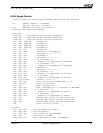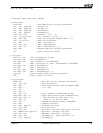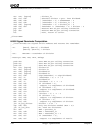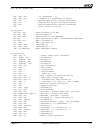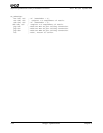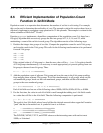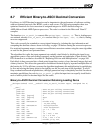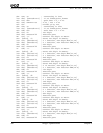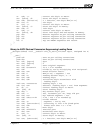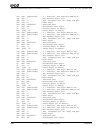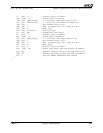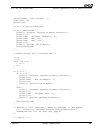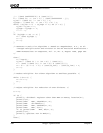
Chapter 8 Integer Optimizations 181
Software Optimization Guide for AMD64 Processors
25112 Rev. 3.06 September 2005
8.7 Efficient Binary-to-ASCII Decimal Conversion
Fast binary-to-ASCII decimal conversion can be important to the performance of software working
with text oriented protocols like HTML, such as web servers. The following examples show two
optimized functions for fast conversion of unsigned integers-to-ASCII decimal strings on
AMD Athlon 64 and AMD Opteron processors. The code is written for the Microsoft Visual C
compiler.
The function uint_to_ascii_lz converts like sprintf(sptr, "%010u", x). That is, leading zeros
are retained, whereas uint_to_ascii_nlz converts like sprintf(sptr, "%u", x); that is, leading
zeros are suppressed.
This code can easily be extended to convert signed integers by isolating the sign information and
computing the absolute value as shown in Listing on page 130 before starting the conversion process.
For restricted argument ranges, construct more efficient conversion routines using the same algorithm
as used for the general case presented here.
The algorithm first splits the input argument into suitably sized blocks by dividing the input by an
appropriate power of ten and working separately on the quotient and remainder of that division. The
DIV instruction is avoided as described in “Replacing Division with Multiplication” on page 160.
Each block is then converted into a fixed-point format that consists of one (decimal) integer digit and
a binary fraction. This allows the generation of additional decimal digits by repeated multiplication of
the fraction by 10. For efficiency reasons the algorithm implements this multiplication by multiplying
by five and moving the binary point to the right by one bit for each step of the algorithm. To avoid
loop overhead and branch mispredictions, the digit generation loop is completely unrolled. In order to
maximize parallelism, the code in uint_to_ascii_lz splits the input into two equally sized blocks
each of which yields five decimal digits for the result.
Binary-to-ASCII Decimal Conversion Retaining Leading Zeros
__declspec(naked) void __stdcall uint_to_ascii_lz(char *sptr, unsigned int x)
{
__asm {
push edi ; Save as per calling conventions.
push esi ; Save as per calling conventions.
push ebx ; Save as per calling conventions.
mov eax, [esp+20] ; x
mov edi, [esp+16] ; sptr
mov esi, eax ; x
mov edx, 0xA7C5AC47 ; Divide x by
mul edx ; 10,000 using
add eax, 0xA7C5AC47 ; multiplication
adc edx, 0 ; with reciprocal.
shr edx, 16 ; y1 = x / 1e5
mov ecx, edx ; y1
imul edx, 100000 ; (x / 1e5) * 1e5
sub esi, edx ; y2 = x % 1e5
mov eax, 0xD1B71759 ; 2^15 / 1e4 * 2^30
mul ecx ; Divide y1 by 1e4,



